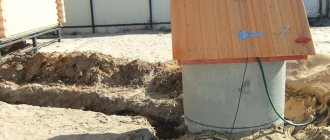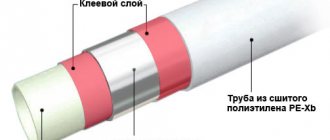A water pipe can freeze for various reasons. If, when laying the water supply system, the requirements of GOST were violated and the propylene pipes were laid at an insufficient depth. Poor pipe insulation or lack of insulation. When water consumption is low or in the absence of residents, when water consumption is zero and there are abnormal frosts outside. Whatever the reason, frozen water pipes must be warmed up. The heating method will depend on where the ice jam occurred: underground or in the house.
Finding the freezing point
Before you start defrosting the pipe, you need to find the area where the ice plug has formed. You can do this in two ways:
- visually inspect the pipe. When water freezes, it expands and the ice plug can push the plastic propylene pipe apart. Externally, there will be a visible thickening on the pipe;
First of all, it is necessary to determine the location of the ice jam.
- the second method is used if there is no way to visually inspect the pipeline. In this case, turn off the tap and then dismantle the nearest detachable connection or cut the pipe. Then a metal flexible cable is inserted into the pipe. Using the length of the cable, you can calculate the distance to the freezing point.
The procedure for further action to remove the ice plug will depend on where exactly the propylene pipe is frozen.
Warming up pipes from the inside
To get rid of a blockage in sewer pipes, you will have to take into account a number of features. Firstly, such communications, as a rule, have a fairly large diameter, which allows for better heating from the outside and inside. However, the amount of ice accumulated in them will be significantly greater, so greater heat consumption by heating devices will be required.
To defrost plastic pipes you will need one simple device. We take a board with rounded edges and attach a U-shaped heating element to it. Only the heater loop should protrude beyond the board. All other parts must not come into contact with the walls of the heating device.
Having determined the thickness of the plug and the distance to it, we attach wires of the appropriate length to the ends of the heating element, and attach the entire structure to a section of metal-plastic pipe, which we will use to push our device into the sewer.
The structure must be inserted into the drain pipe from the receiver side, where the melted liquid will flow. First, the heating element is fully advanced to the place of work, after which it is connected to the network. Moving the device forward as the plug thaws, the device is periodically turned off.
Defrosting water pipes with electric current
You will need copper wire with two cores with a cross section of 2.5 mm. The wires are separated and pulled apart. Then the end of one core is exposed in such a way that several turns of the exposed wire can be made around the other. The wires must not touch each other to avoid a short circuit. A plug is connected to the opposite end of the wire.
Wire for electric current
The wire is pushed into the water pipe until its ends rest against the ice plug and the plug is plugged into the network. The heating process resembles the operation of a household boiler. The current passes through the water and heats it. This method is safe for the pipe; only water is heated, so melting of the propylene water supply is excluded.
Advice. Before inserting the boiler into the pipe, you should test the device. Dip the end of the bare wire into a bucket of water and plug in the plug. Bubbles and a slight buzz should appear. Do not put your hands into the bucket under any circumstances to avoid electric shock.
Overview of different methods
The water supply can be defrosted using various methods of applying external heat to the pipe, or by defrosting it from the inside.
Method 1. Use hot water
If there is a suspicion that the water supply is frozen in an open area - at the entrance to the house, in an unheated basement, etc., boiling water is used to warm it up.
To do this, you must first wrap the pipe with any rag that will absorb water and prolong the time the pipe is in contact with boiling water. Pour hot water until the ice begins to melt. And to speed up the process, the tap must be left open.
The easiest way to warm a frozen pipe is to pour boiling water on it.
This method is used only indoors, because if the pipe is underground, it will take a long time to warm it with boiling water - at least 12 hours.
Method 2. Use a hair dryer
The pipe can be defrosted using hot air produced by a powerful hair dryer. The surface of the pipe is blown from all sides, and to reduce heat losses it is recommended to erect a small pavilion made of plastic film, for example, over the frozen pipe. If the pipe is plastic, you need to correctly calculate the heating so as not to melt it.
Solving the problem of defrosting a water pipe using a conventional hair dryer, but you can also use a construction tool
If the pipes freeze slightly, you can use a household hair dryer or fan heater to warm it up. If there are turns, narrowings, or entrances to fittings, they also need to be warmed up, as ice pieces can get stuck there. And in this case, do not forget to leave the tap open.
Method 3. Electric current comes to the rescue
How to warm a frozen water pipe using electric current?
Heating of a metal water supply can be done using a welding transformer: the positive wire is connected to one end of the pipe, and the negative wire to the second. In this simple way, the problem can be solved in a few minutes: the ice plug will melt.
The time for heating frozen metal water pipes with a welding transformer is minimal
Heating of a plastic pipeline can be done using a two-core copper wire with a cross-section of 2.5 mm. This method is similar to the operating principle of a conventional home boiler. The wire strands are disconnected. One of them is simply bent, and the second is exposed and twisted 3-5 turns around the wire, cutting off the excess end. They do the same with the first core, retreating 2-3 millimeters from the turns of the second core. You need to pay attention so that the wires do not touch, otherwise a short circuit will result. A plug is connected to the other end of the wire. The wire is pushed into a plastic pipeline and connected to the electrical network. Passing through the water, the current heats it up and the ice begins to melt.
The good thing about this method is that only the water heats up, while the wires remain cold and this prevents accidental melting of the plastic pipe. To quickly blow out melt water, you will need an additional compressor.
Method 4. We heat the pipeline from the inside using improvised means
How to heat a water supply system if it has many bends and sections? For such a case, you can build a special device. You will need a wire, a hydraulic level tube, an Esmarch medical mug (in simple terms - an enema), which consists of a rubber container with a rubber hose and a small tap for draining water. The hydraulic level tube is secured to the wire using electrical tape so that the end of the tube is slightly longer than the wire. Push it into the water supply until it stops. Hot water flows from the rubber reservoir into the pipeline. It is necessary to organize the collection of melt water.
Schematic representation of the warming process using wire and enema
As the ice thaws, the tube with the wire is pushed further. The process of heating a frozen water pipe using improvised means is quite labor-intensive and requires a lot of patience and time (about 1 hour per meter of frozen pipe), but the costs are minimal.
Method 5. Call specialists
You can also warm up a water pipe from the inside using special equipment - a hydrodynamic unit, the direct purpose of which is preventive flushing of water and sewer pipes.
Hot water with a temperature of 150 degrees is supplied under high pressure (90-100 atm) through the hose. The water boiler of the installation runs on diesel fuel, and the unit is powered by an electrical network with a power of at least 7 kW and a voltage of 380V. This method requires calling specialists, so this method is not suitable for everyone.
We use a steam generator
A steam generator is a special machine that regenerates steam and supplies it under pressure. The fitting is inserted into the water pipe and hot steam melts the ice plug. This is the most effective and fastest way to clear an ice jam. There is only one drawback - not every home has such a device. But if you have a double boiler or autoclave, they can also be used for heating. When using them, the procedure is as follows:
You can use a steam generator to defrost the water supply.
- Pour water into one of the listed units.
- One end of the heat-resistant hose is connected to the autoclave fitting.
- We push the other end into the water pipe to the freezing point.
- Turn on the heating device and wait for the result.
- We monitor the water level in the autoclave.
How to find a problem area
The most difficult moment in this matter is to determine the location of freezing in an open section of the water supply system. Experienced craftsmen advise focusing on temperature sensations when inspecting and probing the accessible part of the route.
It is not difficult to determine the location of an ice plug in a plastic pipeline by palpation: within the blocked area, when you try to slightly bend the pipe, a characteristic crunch is heard
Water pipes usually freeze in areas where the pipes come close to the ground. Technical wells and unheated basements are also vulnerable to frost.
It has been noticed that concrete freezes faster than soil layers. Therefore, if the basement was unreliably insulated or was slightly opened during periods of severe frost, it is quite natural that the pipeline running in it froze.
If the freezing area cannot be determined, it is better to immediately abandon the idea of breaking through the ice jam using mechanical methods.
If it is not possible to “calculate” a specific area, use available methods at once on several of the most likely freezing areas.
Submersible pump and barrel to help
You will need a metal barrel, a bucket, a pump and a hose.
- The water in the barrel must be constantly heated. A fire or blowtorch will do.
- A hose from the pump is inserted into the water pipe. Thus, the water will flow out into the bucket through the gap between the tubes.
Scheme: defrosting pipes using hot water and a pump - The pump pumps water from the barrel into the pipe to the ice plug. As the ice melts, the hose is carefully pushed deep into the pipe until the ice plug is completely defrosted.
Advice. Propylene pipes are connected with fittings that do not narrow the internal diameter of the pipe at the joints, so the process of removing ice plugs is greatly simplified compared to pipes made of other materials.
What to do if the well freezes?
The construction of a well for water supply to a country house or country house has become quite popular in recent years. Such a hydraulic structure allows you to obtain a stable and independent water supply. However, if the structure itself is not made in compliance with the technology, if there are violations of operating rules, or if you do not know how to insulate the well, then this can lead to various problems, and one of them may be freezing of water in the structure. In this case, water can freeze in different places of the structure. In our article we will tell you what to do in this case, how to prevent such situations. The video at the end of the article will help you understand the intricacies of well operation.
Internal defrosting using improvised means
This method is similar to the one we described above. But not everyone has an iron barrel with a pump and the ability to make a fire, but Esmarch’s mug (popularly known as an enema) can probably be found in every home. So, for work you will need:
- enema;
- wire;
- a tube.
Scheme: defrosting a water pipe using an Esmarch mug.
The tube and wire are connected with electrical tape so that the end of the wire is shorter than the end of the tube. Push the tube all the way into the ice. Open the tap on Esmarch's mug, which is pre-filled with hot water. The water flows to the ice plug, and the melted water will pour out into the substituted bucket. As the ice decreases, the wire is pushed further. It should be noted that this method will require a lot of patience and time.
Video description
Which water well option to choose can be found here:
However, the presence of these advantages will require the owner of the site to carry out periodic preventive maintenance to clean the clogged device. As a rule, this cleaning is carried out in several ways:
- using a bailer;
- pumping the well with a vibration pump;
- using two pumps (deep and rotary).
The use of these methods involves both their separate use and joint use in turn. It all depends on the clogging and depth of the well.
Cleaning work using a bailer
The bailer (metal pipe) is secured with a strong iron cable or rope and smoothly lowers to the bottom. When it reaches the bottom, it rises (up to half a meter) and drops sharply. The impact of the bailer under the influence of its weight is capable of lifting up to half a kilogram of clay rock. This method of cleaning a well is quite labor-intensive and long-term, but inexpensive and effective.
Cleaning a well with a bailerSource yaplakal.com
Cleaning work using a vibration pump
This well cleaning option will be the simplest and fastest. That is why it is considered the most common and has found application even in mines that have a narrowed receiver, which is why the use of a conventional deep-well pump is not possible.
Cleaning with a vibration pumpSource RSU-61.rf
Cleaning work with two pumps
This method is characterized by the fact that it virtually does not require human participation in the process. The well is flushed using two pumps, which handle all the work themselves, but the time required for this is simply enormous.
External heating of propylene water supply
External heating of the water supply is quite simple. There are several ways to do this. But first they open the taps so that the melted water and ice can come out.
- Hot water . Any rag that absorbs and retains water well is wound onto the pipe over the freezing area. To avoid damaging the pipe, the water temperature is increased gradually. Any container to collect water is installed under the pipe. It will take more than one cycle of squeezing out the rag and pouring hot water over it again.
If you need to defrost a small area, you can use a hairdryer
- Hairdryer. A hair dryer can be used as a heat source. This requires great care and skill in working with this power tool, since the propylene pipe can be melted by negligence. Fan heaters and other electric heaters are used, but this method is not effective enough, since a large amount of the heat generated is wasted. For a very small area of freezing, a regular hair dryer will do. Additionally, build a small casing to trap warm air.
- Self-heating electric cable , it is also used when installing heated floors. The cable is wrapped around the pipe and plugged into the network.
Advice. Do not use a blowtorch, wax candles or a fire to heat propylene pipes - they will melt. Such methods can be used for frozen metal water pipes.
- Hydrodynamic machine. If all the methods have been tried, but there is no result, call a specialist. In a matter of minutes, they can remove ice blockages using a hydrodynamic machine, the main application of which is cleaning water and sewer pipes with water. The water equipment of the unit runs on diesel fuel, and the installation itself is powered by the network. The machine creates high pressure of hot water and is capable of breaking even harder materials than ice, so the use of such equipment requires qualifications and knowledge of safety precautions.
Simple ways to solve the problem
The localization of the ice plug has been established; it remains to resolve the question of how to warm up plastic pipes without making much effort.
When heating ice, it should be taken into account that it obeys the same laws of physics as any other solid body. When water becomes ice, its volume increases. Ice, when heated, expands before melting. If you heat it up sharply, the plastic line may not withstand it and burst. Therefore, it is better to spend a little more time to preserve the pipeline than to try to speed up the process of rendering the plastic plumbing unusable.
For highways located indoors, one of the options would be to heat it with electric heaters. If this method cannot be applied, we use external defrosting methods:
- The most popular method is boiling water. It is used to water the area where the plastic line is damaged. To reduce heat loss, the area is wrapped in several layers of rags. To make the process go faster, you need to open the nearest tap; as soon as the ice melts, the resulting flow of water will prevent it from forming again.
- Ice can be melted with a regular or construction hairdryer. In the latter case, care must be taken; the outlet temperature is 250°. If you overdo it, the pipe may melt. A canopy made from scrap material will help reduce the consumption of warm air.
- A financially expensive, but pipe-friendly method, is the use of metal-plastic systems for heated floors. They are wrapped around the frozen area, then connected to the power supply.
Measures to prevent pipeline freezing
At the first opportunity, when warm weather sets in, it is necessary to take measures to insulate the water supply in order to avoid such a nuisance in the future. Deformed areas will need to be replaced.
- Water supply pipes are laid below the freezing level of the soil.
- The pipe is wrapped in high-quality thermal insulation; if necessary, an additional heating cable is laid along the pipe.
Insulation of water pipes - The places where the pipe passes through the foundation are additionally insulated, since concrete freezes faster than soil. The pipe is placed in a pipe of larger diameter and foamed with polyurethane foam.
- The basement pipes are wrapped in thermal insulation: mineral wool, glass wool, or a special insulation for pipes in the form of a cylinder.
But while the frost is crackling outside, not all insulation methods can be used, and there is no point in chiseling the frozen ground. We can recommend one effective action - although this is a violation of safety rules: keep the tap slightly open so that the water flows in a small thin stream, and then the moving water stream will not allow ice to form.
How to warm up a frozen water supply: video
https://youtu.be/5J6mr1PFE_g
Methods for defrosting water supply: photo
Preparing for long periods of downtime and pumping after it
If visiting a summer cottage in the winter (or for another long period) is not expected, and the well will also not be used, then you should take care of this in advance. It is necessary to think about preparing the device for inactivity and how to pump the well after winter or long periods of inactivity.
Preparation comes down to installing a heating cable inside or using any available materials to insulate the device.
Pumping the well after winter is carried out using standard methods, which are described above, and is used only if necessary.
An example of insulating a well for the winterSource tildacdn.com
A private well on your own property is a useful and absolutely necessary thing. However, it will require some periodic maintenance work for cleaning and rocking. It is described above what pumping is, what it is used for, what pump to pump the well after drilling, how to do it correctly and in what way, and what are the features of using this or that option. The issues of preparing the device for long-term downtime (wintering) and restoring performance after this period are also mentioned.











